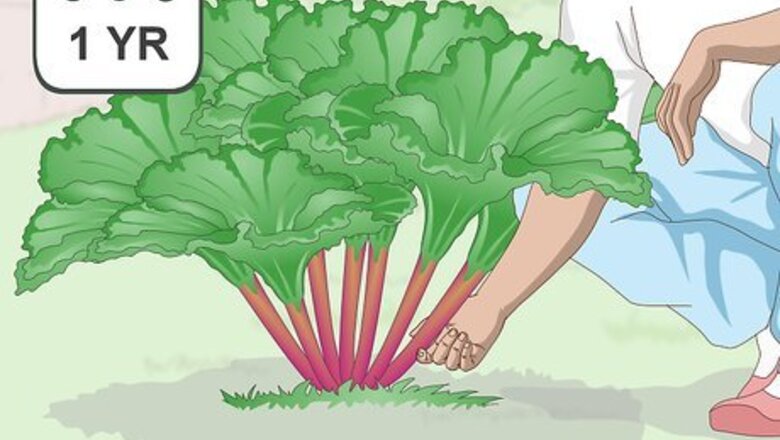
views
- Harvest rhubarb for 8-10 weeks in the spring and early summer—from May to June in the northern hemisphere.
- To pick rhubarb, grasp a stalk, twist it, and pull it away from the base of the plant. Avoid cutting the stalks off the plant, which could lead to diseases like crown rot.
- Remove and discard the leaves, which contain oxalic acid and are poisonous, as soon as you harvest the rhubarb stalks.
When to Harvest
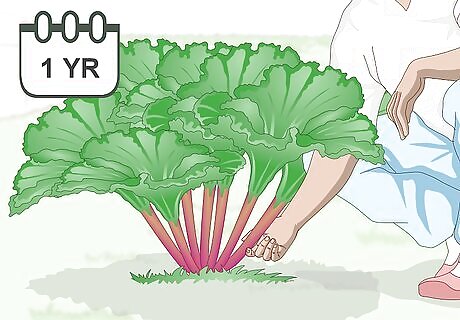
Wait at least 1 year before picking stalks from a new rhubarb plant. If you’re growing a new rhubarb plant, don’t harvest during the first year. The plant needs time to develop a strong root system, and harvesting too soon will weaken the young rhubarb plant. Leave all stalks intact for the first year. During the plant’s second season, only harvest 3-4 stalks to ensure the plant stays strong for the following seasons. A rhubarb plant can produce stalks for up to 20 years, but usually needs to be divided after 5-6 years. Expect to get about 2 to 3 pounds (0.91 to 1.36 kg) of stalks from a mature plant each season.

Harvest rhubarb from May to June in the northern hemisphere. Rhubarb’s harvesting season only lasts 8-10 weeks in the spring and early summer. Start harvesting in May and plan to stop harvesting at the end of June. Rhubarb stalks get tough and woody as the summer progresses. Harvesting too late in the season can also stunt growth for the following season. You may have heard that the oxalic acid from the leaves moves into the stems during periods of cold weather and makes them poisonous. This is debated among horticultural experts, and some say still-crisp stalks aren’t toxic. To be on the safe side, avoid eating rhubarb after a frost.
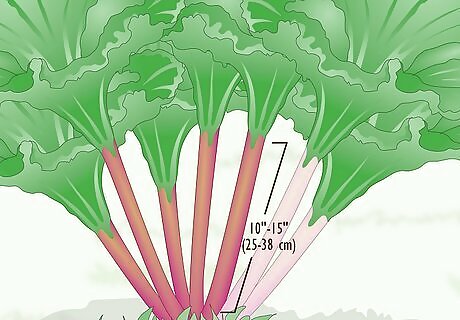
Let the stalks grow to 10–15 inches (25–38 cm) long. The longer the stalk, the more flavorful it will be, so avoid harvesting rhubarb stalks that are shorter than 10 inches (25 cm). Don’t count the leaves in your measurement—just the stalks.
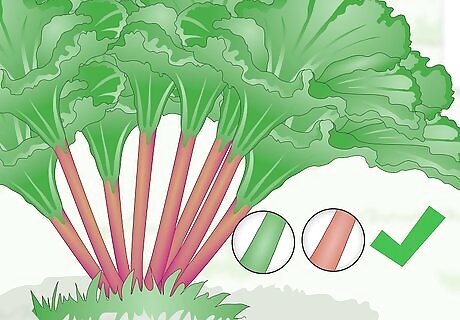
Avoid judging a rhubarb plant's ripeness by its color. Contrary to popular belief, how red or vibrant the stalks are does not determine how ripe the plant is. Not all rhubarb is a deep red hue. Some varieties of rhubarb are speckled (pink) or green when they're ready to be picked. Canada Red and Crimson Red varieties produce bright red stalks. Victoria and Glaskin’s Perpetual are speckled or pink varieties of rhubarb. Turkish and Riverside Giant are common green varieties of rhubarb.
Picking Rhubarb

Choose stalks that are firm and crisp. Feel the stalks with your hand to make sure they’re good. Pull and discard any stalks that are damaged or mushy. Rhubarb stalks usually grow to 1–2 inches (2.5–5.1 cm) in diameter. Don’t harvest from a plant whose stalks are very thin, which is an indication that the plant is weak.
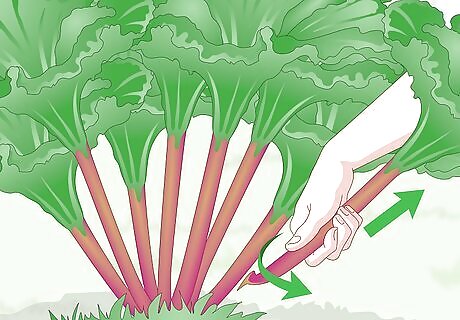
Twist and pull the stalks as close as possible to the base of the plant. Always twist rhubarb stalks clean from the crown, as twisting or pulling invigorates the roots to produce more. Pull gently, while twisting the stalk to ensure it comes away neatly. Don’t cut rhubarb! Knife wounds can lead to crown rot, which can destroy your rhubarb plants. Make sure not to cut or damage the central bulb of the plant which can stunt its growth.
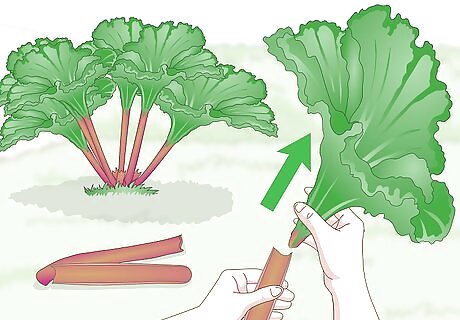
Pull or cut the leaves from the stalk and discard them. The leaves contain oxalic acid, which is poisonous. Never eat the leaves! Instead, cut them off the stalk using a sharp knife and discard them. Even though the leaves contain oxalic acid, you can add them to the compost. The oxalic acid won’t be absorbed by plant roots.
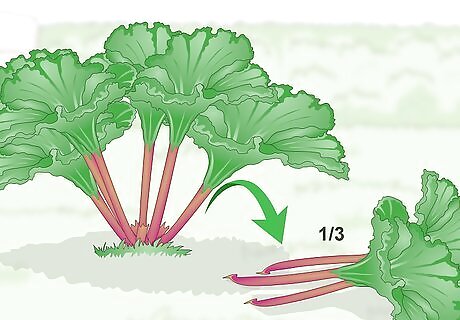
Collect only a third of the stalks per plant each season. Over-harvesting will weaken the plant. Always leave at least 6 stalks on the plant at all times. Just leave the rest of the plant intact instead of cutting it down. The foliage will die back while the roots store food reserves for the winter.

Remove broken or flowering stalks from the base. Broken stalks on the rhubarb plant drain its energy and can allow disease and infection in. Either trim and eat the pieces or discard them. Cut the entirety of flowering stalks from the base of the plant to prevent weakening the plant and decreasing stalk yield. Trim off leaves that are wilted or eaten by insects so they don't affect the rest of the plant.
Rhubarb Storage
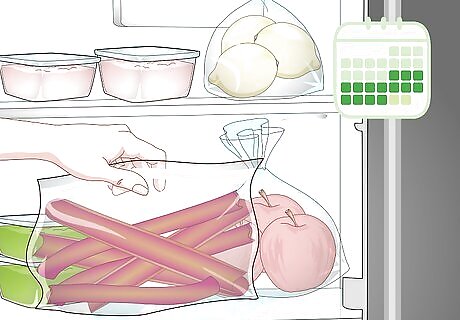
Store rhubarb in the fridge for 2-4 weeks. Don't wash the rhubarb until you're ready to eat it. Place your rhubarb in a perforated plastic bag to allow air to circulate around it. The best spot in the fridge for your rhubarb is the vegetable crisper drawer because it has the highest humidity and won’t dry out the stalks. Keep your refrigerator at a temperature of 32 to 40 °F (0 to 4 °C) for storing rhubarb.
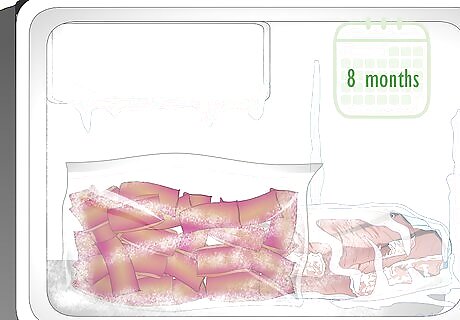
Freeze the rhubarb for up to 8 months. Rinse your rhubarb and pat it dry with a paper towel. Then chop the rhubarb into ⁄4–1 inch (0.64–2.54 cm) pieces and put them in an airtight container or resealable freezer bag. Place the container in the freezer to use within 8 months. If you’re using a freezer bag, remove any excess air before sealing it shut. Label your container or bag with the date and the contents using a permanent marker. Frozen rhubarb is great for smoothies or baking rhubarb pies.
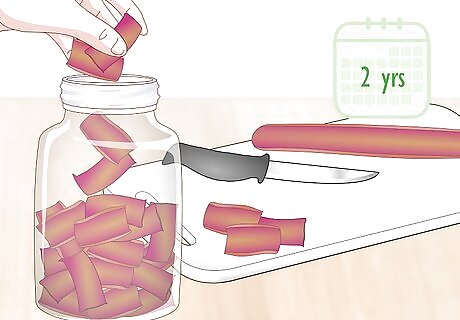
Can rhubarb to preserve it for up to 2 years. Wash the stalks and cut them into ⁄2–1 inch (1.3–2.5 cm) pieces. Put them in a large saucepan with 1/2 cup (100 g) of sugar for each quart of rhubarb. Once you see juice appear, heat the mixture gently to boiling, then pack the rhubarb in hot quart jars. Leave ⁄2 inch (1.3 cm) of headspace, remove any air bubbles, wipe the rims, and seal the jars. Boil them in a water bath for 15 minutes, let them cool, and store them.


















Comments
0 comment